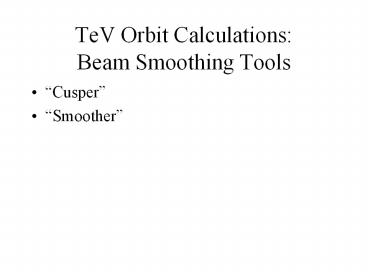TeV Orbit Calculations: Beam Smoothing Tools - PowerPoint PPT Presentation
Title:
TeV Orbit Calculations: Beam Smoothing Tools
Description:
Slide the fits so that a single cusp does not spoil the identification of mavericks ... Cusp fitter implemented but as yet not at tested/tuned ... – PowerPoint PPT presentation
Number of Views:20
Avg rating:3.0/5.0
Title: TeV Orbit Calculations: Beam Smoothing Tools
1
TeV Orbit CalculationsBeam Smoothing Tools
- Cusper
- Smoother
2
Cusper
- Fitter to detect distortions in the magnetic
field based on deviations from the expected form
of the beam position measurements - Includes heuristics for rejecting BPM
measurements as suspected bad readings - Identifies positions and strengths of apparent
distortions
3
Smoother
- Tool to suggest optimum DFG settings to correct
for distortions - Optimization includes criteria which existing
tools do not - Recognition of DFG current range restrictions
- Penalty for larger DFG currents
- Penalty for large inter-step slew
4
Identifying Maverick Readings
- Technique
- Local sine-curve fits to BPM data (corrected for
b function) - Fit with and without a key point (or pair of
points) to be evaluated - Bayesian approach Assume some a priori
likelihood of a given measurement being bad - Which is more likely?
- the (worse c2) probability of the fit including
the key point - the (better) probability of the fit excluding the
key point, times the assumed likelihood of a bad
measurement - Slide the fits so that a single cusp does not
spoil the identification of mavericks
5
Subtleties in Identifying Mavericks
- There are various ways for the data to fool a
heuristic for identifying mavericks - The presence of a maverick, coupled with unlucky
normal fluctuations, to cause - incorrect rejection of a good reading
- incorrect acceptance of a bad reading
- Unit-testing the code exposed a number of such
headaches
6
Subtleties in Identifying Mavericks
- The presence of a true maverick here distorts the
fit such that an acceptable measurement is
rejected - Modifications to the heuristic to correctly
handle most of these subtleties have been made. - Some situations still fool the filter, but these
now involve very rare combinations of
circumstances
7
Identifying Cusps
- Fit with varying window sizes and positions
- Find three best fit curves
- across the interval in question
- just to the right of the interval
- just to the left of the interval
- Again a Bayesian approach is used
- Some a priori likelihood for distortion in any
given interval - Which is more likely?
- the (worse c2) probability of the fit without a
distortion - the (better) probability of the fit excluding the
key point, times the assumed likelihood of a
distortion - Last-pass overall optimization of cusp positions
and magnitudes
8
Cusper Status
- Can read BPM and Twiss parameter info from a
couple of formats and use it to try to do the fit - Display capability via Root
- Rejection filter implemented and unit-tested and
tuned - 99 of the effort, as usual, went into the
boundary and pathological cases - Cusp fitter implemented but as yet not at
tested/tuned - Major issue once the linux-based cusper exists
- How (and whether) to integrate this with the
control-room accessible tools - Effort has been on back burner for a while
9
Smoother
- Given the BPM readings and the desired target
orbit readings, find the best DFG settings to
correct the orbit. - Global optimization across time steps in the
ramp and squeeze, to minimize large slews - Avoidance of suggested currents which are too
large for the DFG to handle - Consideration to avoiding large total currents
- Two DFGs should not fight each other at large
currents - The overall optimization can be computationally
intense - This has been on the back burner for quite a
while - When the tool exists, integration with
accelerator controls will also be an issue
10
Beta Tool
- Once
- cusper is implemented
- new BPMs are in place
- it becomes possible to evaluate, for a given
frame, the corrections to the b function which
would explain BPM fluctuations not explained by
identified cusps. - A single such measurement is not very meaningful.
- An ensemble of these corrections, over time,
might be helpful in determining the b function to
better accuracy. - Is this something people would be interested in?































